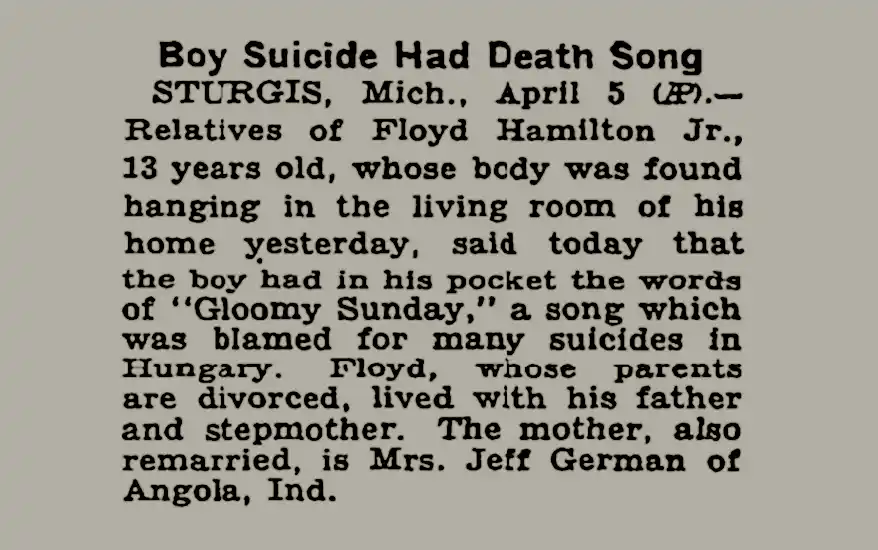
Telekinett is pleased to unveil a narrative that delves into themes of darkness and metaphysics, spotlighting John Duncan, a distinguished figure among contemporary Electroacoustic composers.
(Adjust volume before playing)
The narrative associated with Gloomy Sunday has evolved into a legend. Both the song and its accompanying tale have received extensive coverage in prominent newspapers and magazines due to their alleged unsettling link to numerous suicides. “Gloomy Sunday” (Hungarian: Szomorú Vasárnap), often referred to as the “Hungarian Suicide Song,” is a well-known piece created by Hungarian pianist and composer Rezső Seress, first published in 1933.
The composition of the song was undertaken by Rezső Seress during his residence in Paris, as he sought to establish himself as a songwriter in late 1932. The initial musical arrangement featured a piano melody in C minor, with the lyrics performed over it. Seress created the piece amidst the backdrop of the Great Depression and the rising influence of fascism in his homeland of Hungary. However, opinions vary regarding whether the song was primarily inspired by his personal sorrow or by broader concerns about the future. The essence of Seress’s lyrics conveys a critique of human injustices, accompanied by a plea to God for mercy on the contemporary world and its wrongdoers. There are indications that the lyrics of “Vége a világnak” may not have been penned until the onset of World War II and were not copyrighted until 1946.
Mauricio Reyes conducted extensive research on the subject of suicide and initially suggested a journalistic approach for this project. However, John Duncan noted that this approach had already been explored. Instead, he suggested using a piece he had composed for his own funeral, which connects “Gloomy Sunday” and its links to suicide.
The song faced a ban in Hungary, but this issue extends beyond its borders. In the 1930s, both Time and the New York Times documented instances of suicides and suicide attempts in the United States linked to “Gloomy Sunday.” The BBC and various media outlets in the US reportedly declined to broadcast it, apprehensive that it might be associated with these tragic events.
Initially, Seress faced challenges in securing a publisher, largely due to the song’s notably somber tone. One prospective publisher remarked, “It is not merely that the song is sad; it evokes a profound and terrible despair. I doubt it would benefit anyone to hear such a piece.”
The song was eventually published as sheet music in late 1933, featuring lyrics by poet László Jávor, who drew inspiration from a recent breakup with his fiancée. Most accounts suggest that Jávor revised the lyrics following the song’s initial release, although he is occasionally referred to as the original author of the words. His lyrics did not express political themes; instead, they served as a lament for the loss of a loved one and a promise to reunite in the afterlife. This rendition of the song gained widespread recognition, and most subsequent adaptations revolve around the theme of lost love.
Over the years, numerous urban legends have emerged surrounding the song, primarily suggesting a connection to various instances of suicide, which allegedly led to radio stations banning it. In the 1930s, media reports linked at least 100 suicides, both in Hungary and the United States, to “Gloomy Sunday.” On January 11, 1968, approximately 35 years after the song’s creation, its composer took his own life.
“Gloomy Sunday: The Funeral I envision for Myself” transcends a mere journalistic endeavor. It serves as a profound investigation into the somber and isolating realm of mental illness. Mauricio Reyes embarked on this sonic journey with a variety of ideas and concepts. These notions were communicated to John Duncan, who skillfully integrated his own funeral score with this timeless, beautiful, and haunting composition that explores the forgotten regions of the heart.
The BBC prohibited Billie Holiday’s rendition of the song from airing, although instrumental versions were permitted. This ban was eventually lifted in 2002.
The Metaphysics of Suicide
While the urban legend appears to be, for the most part, simply an embellishment of the high number of Hungarian suicides that occurred in the decade when the song was composed due to other factors such as famine and poverty. No research has established a definitive connection between the song and suicide.
HOWEVER, THAT BEING SAID, the song lyrics, regardless of a clear link between the song and suicide bring up the awareness of the importance of our thoughts! “Mind activates principle which produces results.”
Today’s market is filled with the importance of your “state of mind.” “You become that which you think about, etc.” “Think and Grow Rich”, could also be “Think loss and depressive thoughts and end it all! “
What causes this effect? Basically, BELIEF SYSTEMS!
From a Metaphysical viewpoint:
Karma = “Everything is instantaneously just!”
The person who has gone on has completed their cycle.
The person remaining is experiencing loss, Possession of another person, & most important, control! Lesson to learn is not to possess, as we cannot even possess our own bodies, sooner or later we will step out of it into the light. CONTROL, Death of another is out of our control.
Lesson is to be in the NOW and go with the FLOW. “GOD” CREATIVE ENERGY, is never still, never rest! If that ENERGY rested, your heart wouldn’t beat and the tides wouldn’t ebb and flow.
KARMA = WHAT DECIDES when a person has completed their cycle? We have a Conscious Mind, a Sub-Conscious Mind, and Metaphysic’s teaches we have a Super-Conscious Mind.
The Super-Conscious Mind is that part of our consciousness that is in tune with our “Soul” vibration, purpose. Our purpose is to re-unite with that from which we came.. Light, God, etc.
If we follow the lives of the great Avatars, they all demonstrated a state of consciousness that had total awareness of God, God, God! If we study the Aramaic language which Jesus spoke, it gives an entirely different viewpoint of the crucifixion other then that created by the minds of the Niaceen Council. Had nothing to do with “saving” souls through blood atonement of a sacrificial lamb……”My God, My God for this was I born, This was my destiny.” A demonstration of AT-ONE-MENT Consciousness. Meister Eckhart said of Jesus, “ Not only begotten (because we are all begotten (came from) God, but his consciousness was BEGOTTEN ONLY. Jesus also taught, “Greater things than I have done, ye shall do also.” (John 14:12) How so, through the refinement of one’s consciousness.
WHERE DO WE GO FROM HERE?
“In my Father’s House are many mansions.”
(John 14:2-6)
Some believe there are 7 planes and 24 gradations within each plane and when you reach the 7 plane, 24th gradation, the next step is number 8, which is unending and goes on forever. You are back to the source from which you came.
Judgement is a vibrational thing like a middle C tunning fork. Only Middle C will vibrate with Middle C vibrations……The planes and gradations are vibrations as such and when you pass, your vibration will take you to the plane and gradation that you vibrate with accordingly. That means you will be with people JUST LIKE YOU! However, You only have to stay at that vibration until you DESIRE to progress. Desire being one of the most important things of life.
Nature of Heaven to different people means that some souls will believe that there are Pearly Gates as the entrance of heaven. IF that is an indelible belief, I am sure there will be Pearly Gates for them, as like all things, they created them.
HELL? THE early church father’s when they supposedly had visions of “HELL” came back with there were thick dark clouds of smoke, like the fire’s of Gehenna, which is where they burned the trash outside of Jerusalem. SO, where’s there is SMOKE, there certainly must be FIRE! FIRE AND BRIMSTONE became a part the description of Hell. Those things could harm the physical body but certainly not the spirit. However, there are belief systems that purport that you lie in your grave until the final resurrection, and then at that time all souls will be judged and you and your resurrected physical body will be sent to eternal fire and damnation, etc.
Most people want to reunite with those who have gone on, and there are those that have gone on that are not aware that they have died!
Much research and many demonstrations have been conducted over the subject of “Spirit Communication.” Not only in the field of Spiritism, Spiritualism and Para-Psychology has evidence been given of the continued existence of the individual, but thousands of recorded history down through the ages, beginning with Voluspa, the first written records of a communication.
Believe it or not, there are those who have transitioned, and are not aware that they are dead! 100 years ago Dr.Carl Wickland was chief psychiatrist in the National Psychopathic Institute in Chicago. He has been assisted by his wife, who was a psychic medium.
“Thirty Years Among the Dead”, describes souls who were shocked out of their bodies suddenly, such as in war, and would come back to entrance the body of his wife, who was a trance medium in front of a mirror…..Dr. Wickland would explain that they were now a spirit and through their spirit guides and teachers had entered Mrs. Wickland,s body. They were told to look into the mirror and raise their hand, results being absolute shock to many, etc.
These are only a few of the various “Belief Systems” there are many others, too many to mention. HOWEVER, in view of this information, we can go back to the idea that our “thoughts are things”! “Mind activates principle, which produces results.”
So, the point of all of this is that if we have limited viewpoints about what is “spiritually” and what is not, then we create our own reality. If we read the lyrics of gloomy Sunday and realize that it was written in a minor key, this can create an energy which can be depressive and lead one to think of ending it all. This song brings to the forefront of our minds that we and everyone else is born to die.
The question is, How will that be? Gloomy Sunday suggests a “means” to an end, in an unhappy life.



